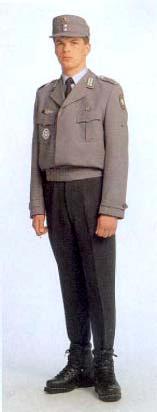|
Gebirgsjäger
 Gebirgsjäger (German pronunciation: [ɡəˈbɪʁksˌjɛːɡɐ]) is a German military term for light infantry trained in mountain warfare. Currently used in the militaries of Germany, Austria and Switzerland, the term includes the word jäger, another German military term used to denote light infantry troops. Origins The mountain infantry of Austria have their roots in the three Landesschützen regiments of the Austro-Hungarian Empire. The mountain infantry of modern Germany carry on certain traditions of the German Alpenkorps (Alpine corps) of World War I. Both countries' mountain infantry share the Edelweiß insignia, established in 1907 as a symbol of the Austro-Hungarian Landesschützen regiments by Emperor Franz Joseph I. These troops wore the edelweiss on the uniform collar. When the Alpenkorps served alongside the Landesschützen on Austria's southern frontier against Italian forces from May 1915, the Landesschützen honoured the men of the Alpenkorps by awarding them their own insignia: the edelweiss. Gebirgsjäger in World War II During World War II the Wehrmacht and Waffen-SS raised a number of mountain infantry units,[1] identified by the edelweiss insignia worn on their sleeves and caps.[2] These divisions were lightly equipped, with much of the transport provided by mules. They were equipped with fewer automatic weapons than regular infantry, however the MG 34 or MG 42 machine gunners were provided with more ammunition than their regular infantry counterparts.[3] Special equipment was made for them including the G33/40 mauser rifle based on the VZ.33 rifle.[4] Mountain infantry participated in many campaigns, including Operations Weserübung, Silver Fox, Platinum Fox, Arctic Fox and Northern Lights. They also served in the Caucasus, the invasion of Crete, the Balkans, the Gothic Line, and the battles in the Vosges region of France. Heer (Army) Mountain divisions
Waffen SS Mountain divisions
Gebirgsjäger in the modern German forces Upon the creation of the Bundeswehr in 1956, the mountain infantry returned as a distinctive arm of the West German army. Until 2001, they were organized as the 1. Gebirgsdivision, disbanded as part of Bundeswehr reductions at the end of the cold war.[5] The successor unit is Gebirgsjägerbrigade 23 which has its headquarters in Bad Reichenhall. The battalions of these units are deployed in southern Bavaria, the only high mountain area in Germany touching the Northern Alps. Since 2008 the unit is officially called "Gebirgsjägerbrigade 23 Bayern (Bavaria)" to mark the close relationship between the state and the Gebirgsjäger. In mid-2020, the official Bundeswehr website stated that the brigade had a strength of approximately 5,300 soldiers.[6] Traditions The soldiers of the mountain infantry wear a grey cap (Bergmütze) with an edelweiss on its left side, stem to the front.[7] This distinguishes them from all other German army soldiers who wear berets and the Austrian army, whose edelweiss has its stem to the back. The formal uniform, which is based on traditional alpine mountain climbing trekking outfits (Berganzug), is also different from the standard mainstream German army uniform, and consists of a light-weight grey ski blouse (Skibluse), black Stirrup trousers (Keilhose) or especially during the summer periods "Culottes" knee-breeches (kniebundhose) similar to knickerbockers, and ankle-height mountaineering boots (Bergstiefel) or dual-use mountaineering ski boots. German Gebirgsjäger traditionally share a very close comradeship and distinct esprit de corps. There is also a special perception of discipline which can for example be seen in a relatively informal relationship between officers and soldiers during normal day duty. Tasks of the German GebirgsjägerThe main tasks of the German mountain infantry are:
23rd GebirgsjägerbrigadeAs of 1 April 2024 the brigade is organized as follows:
Mountain units which are not part of the Gebirgsjägerbrigade 23:
As the Gebirgsjägerbrigade 23 is part of the so-called stabilisation forces (Stabilisierungskräfte), it lacks any accompanying artillery. Mortar support is provided by the Schwere Jägerkompanie (heavy infantry company) in every mountain infantry battalion. Equipment and organization A mountain infantry battalion consists of about 900 soldiers in five companies. One company is responsible for staff and support duties and has a "Hochgebirgsjägerzug" (special platoon for high mountain fight and reconnaissance) at its disposal. Three companies are consisting of classical mountain infantry, another one is a heavy company which is equipped with the Wiesel AWC for mortar support, tank defence and supporting cannon fire with 20 mm guns. Two of the three mountain infantry battalions are equipped with the Hägglund 206S, one with the GTK Boxer.
Gebirgsjäger in the modern Austrian forcesToday the traditions of the Austrian mountain infantry are maintained by the 6th Gebirgsbrigade in western Austria UnitsList of active mountain infantry in the Austrian Armed Forces as of 2013[update]:
Gebirgs troops in the modern Swiss forcesSpecially trained Swiss mountain troops have been a part of the Swiss Army since 1892 when the 3rd Army Corps was established.[9] A central mountain combat school was opened in Andermatt in 1967.[10] Notable membersAlso see Alpenkorps for the World War I era unit.
See also
Similar units
References
External linksWikimedia Commons has media related to Gebirgsjäger.
|